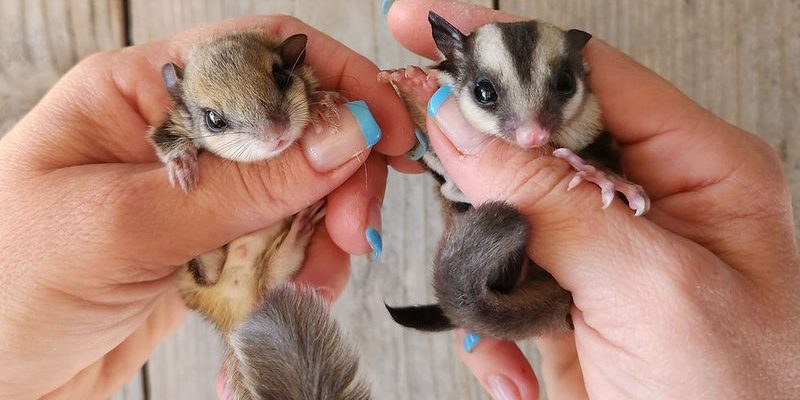![Comparing The Flying Squirrel Vs. [Similar Species]](https://gudri.com/wp-content/uploads/2025/06/Comparing_The_Flying_Squirrel_Vs___Similar_Species__image_0.jpg)
Now, let’s think of these two as the acrobats of the animal world, performing incredible aerial stunts that leave us in awe. While they share some similarities, such as the *gliding membrane* that enables their signature moves, their lives are quite different. So, grab a cup of coffee, sit back, and let’s dive into the amazing world of flying squirrels and sugar gliders.
Physical Characteristics
When it comes to physical traits, flying squirrels and sugar gliders have some noticeable differences. Flying squirrels are generally larger, reaching lengths of up to 12 inches, plus an additional tail of about the same length. Their fur is soft and can vary in color, often appearing gray or brown. On the other hand, sugar gliders are smaller, typically around 10 inches long, with a similar tail that helps them balance during their gliding antics. They often sport a grayish or tan coat with a distinctive black stripe down their back.
In terms of anatomy, both species have a *patagium*, a special membrane that stretches from their wrists down to their ankles, allowing them to glide. This is quite an impressive feature! Imagine it like a parachute, enabling them to catch the wind and soar through the air. However, their wingspan and gliding technique can differ slightly. Flying squirrels tend to glide further, while sugar gliders excel at short bursts of agility and quick changes in direction.
Dietary Preferences
Now, let’s talk about what these two charming creatures munch on. Flying squirrels primarily feast on nuts, fruits, and fungi, while sugar gliders have a more diverse diet that includes *nectar*, *fruits*, and even insects. It’s like comparing a cozy café menu to an all-you-can-eat buffet!
You might be wondering why their diets matter. Well, it ties into their habitats and behaviors. Flying squirrels tend to forage for food during the night, using their impressive sense of smell to locate tasty treats. Sugar gliders, on the other hand, are also nocturnal but have a more varied menu that requires them to be adaptable. They take advantage of seasonal changes, which helps them thrive in various environments.
Habitat and Range
Flying squirrels are found across North America, relying on dense forests to provide both food and shelter. They prefer deciduous and mixed forests, where they can nest in tree cavities or build dreys made of leaves and twigs. Imagine a cozy little home high up in the trees, away from predators.
Sugar gliders, in contrast, are native to Australia, New Guinea, and surrounding islands. They thrive in eucalyptus forests, where they can glide between the tall trees in search of food. Their ability to adapt to different environments has allowed them to become a popular exotic pet in many households around the world. It’s like comparing the charming neighborhoods of a city to the sprawling countryside—each has its own appeal and lifestyle.
Social Behavior
When it comes to social interactions, flying squirrels are more solitary creatures, though they can be found in small family groups. They’re typically quiet and prefer a low-profile lifestyle. Think of them as the introverts of the animal kingdom, sneaking around at night, avoiding confrontation.
Conversely, sugar gliders are highly social animals. They thrive in groups called colonies, which can consist of up to ten individuals. They communicate through a series of vocalizations, like chirps and barks, making them quite chatty. This social nature makes them popular among pet owners who love to engage with their playful antics.
Life Span and Reproduction
Both flying squirrels and sugar gliders have relatively similar life spans, living around 6 to 12 years in the wild, although sugar gliders can live longer in captivity. When it comes to breeding, flying squirrels typically give birth to one to four babies after a gestation period of about 40 days. These little ones are born hairless and need their mother’s care for several weeks.
Sugar gliders also have a short gestation period, around 16 days, and they usually have one or two joeys. These tiny, hairless babies will spend time in their mother’s pouch as they grow and develop. It’s like a little cozy nursery! Interestingly, both species demonstrate parental care, but sugar gliders are often seen sharing the responsibilities within their colonies.
Caring for Them as Pets
If you’re thinking about bringing one of these adorable creatures into your home, there are a few things to consider. Flying squirrels require a large enclosure filled with climbing opportunities and places to hide. They can be a bit shy and might take longer to bond with you.
Sugar gliders, on the other hand, need companionship and thrive better in pairs. They’re more playful and sociable, making them a popular choice for first-time exotic pet owners. However, both species need a special diet, ample space to glide, and a lot of attention. It’s a commitment, but the joy they bring can be truly rewarding.
So, there you have it! We’ve taken a closer look at flying squirrels and sugar gliders, two fascinating creatures that both share the ability to glide through the air but differ in many aspects. From their sizes and diets to their habitats and social behaviors, each has its charm.
If you’re considering adopting one, think about what fits your lifestyle best. Are you looking for a mellow companion or an energetic socialite? Understanding their unique traits will help you make an informed decision. Both animals can bring a lot of joy and wonder into your life. Whether you’re watching them glide or snuggle, they’ll surely capture your heart!

